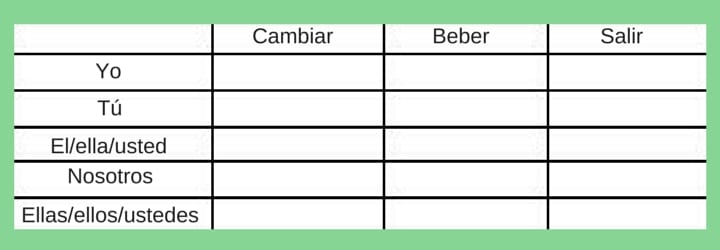As you learn Spanish, the imperfect Spanish conjugation is bound to come up. Learn how to handle them and improve your Spanish grammar knowledge in this post by Fairfax, CA tutor Jason N...
As you probably already know, conjugation is crucial to learning Spanish! As we get to this fourth post in my conjugation series, you may be pleasantly surprised when you realize that it’s all about mastering patterns and formulas!
By now, you have come a long way; you know about conjugating basic Spanish verbs in present tense, stem-changing verbs in present tense, irregular verb conjugations in their yo form, and how to conjugate Spanish verbs in the preterite (past) tense. This post is about learning how to conjugate the imperfect tense Spanish, when to use it, and how it differs from the past tense.
Whereas the past tense refers to a one-time isolated event of the past, the imperfect tense describes past events that occurred in a habitual, repetitive, or routine manner. Identical to the past tense, the Spanish imperfect tense also breaks down verbs into five different ending variants. By now you have probably realized how it works. All we need to do now is learn a new formula for Spanish imperfect conjugations.
As we have already used the example of the verb mirar (to watch) in Spanish, let’s continue to stick with the same example:
How to Conjugate -ar Verbs in the Imperfect Tense:
– Shave off the –ar ending
– If you are referring to yo or ‘I,’ add the ending –aba to end the conjugated verb, forming miraba.
– If you are referring to tú or ‘you,’ use the ending –abas, to form mirabas.
– If you are referring to él or ella or ‘he’ or ‘she,’ use the ending –aba to form miraba. (Yes, this is the same as the yo form!)
– If you are referring to nosotros or ‘we,’ use the ending –ábamos to form mirábamos.
– If you are referring to ellos or ‘they,’ use the ending –aban, to form miraban.
How to Conjugate -er Verbs in the Imperfect Tense:
What about -er verbs? Let’s use comer (to eat) again, for example:
– Shave off the –er ending
– Yo uses the ending ía, (instead of –aba) to form comía.
– If you are referring to tú or ‘you,’ use the ending –ías, to form comías.
– If you are referring to él or ella or ‘he’ or ‘she,’ use the ending –ía, to form comía. (Yes, this is the same as the Yo form as well!)
– If you are referring to nosotros or ‘we,’ use the ending –íamos, to form comíamos.
– If you are referring to ellos or ‘they,’ use the ending –ían, to form comían.
How to Conjugate -ir Verbs in Spanish
This conjugation has the same rules as -er verbs.
Let’s review the following charts of key imperfect conjugation Spanish:
Mirar (to watch):
Yo miraba
Tú mirabas
Él/Ella/Usted miraba
Nosotros mirábamos
Ellas/Ellos/Ustedes mirabanComer (to eat):
Yo comía
Tú comías
Nosotros comíamos
Ellas/Ellos/Ustedes comían
Vivir (to live):
Yo vivía
Tú vivías
Él/Ella/Usted vivía
Nosotros vivíamos
Ellas/Ellos/Ustedes vivían
Ready for some practice? Conjugate the following in the imperfect tense:
What’s the difference between the imperfect and the preterite past tense?
We use the preterite tense in Spanish to describe an isolated event that occurred in the past. This event usually happened only once, and then ended. In this sense, it ‘stays’ in the past. To reiterate, imperfect verbs in Spanish tense, on the other hand, describes past events that occurred in a habitual, repetitive, or routine manner.
Ready for the Quiz: Imperfect Conjugations Spanish?
In which of the following would you use the Spnaish imperfect tense instead of the preterite tense? What would the correct verb conjugation be?
1) I used to play basketball after school with my dad.
2) I went snowboarding with my friends in December of 2007.
3) I would do my homework on Sunday nights after school in high school.
4) I had six pets when I was a teenager.
5) I cut my finger when I was cutting an apple in Yosemite.
BONUS
6) When I was 25, I walked across a tunnel.
In conclusion, in Spanish, imperfect conjugations are the easiest to learn because there are only three irregular verbs: ir, ver and ser, whose stems are iba, veía and era, respectively. If you’re feeling really ambitious, practice these ones. I’ll remind you again to experiment with a Spanish tutor to see how well you can learn this!
Answer Key:
1) I
2) P
3) I
4) I
5) P
6) Trick question! Cuando tenía (imperfect, AND in Spanish we have years, instead of being years) 25, caminé (past tense) por un túnel.
 Post Author: Jason N.
Post Author: Jason N.Jason N. tutors in English and Spanish in Fairfax, CA. He majored in Spanish at UC Davis, lived in Mexico for 3 years where he completed a Master’s degree in Counseling, and studied Spanish Literature and Psychology at the University of Costa Rica. Learn more about Jason here!
Photo by rhodesj
Suzy S.



